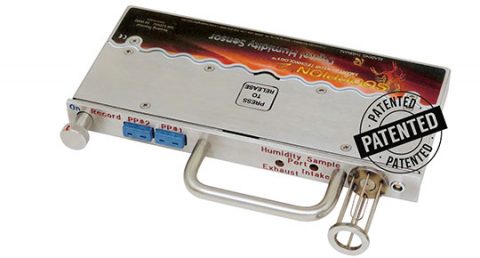Monitoring industrial oven humidity and temperature with sensors from Reading Thermal is a crucial step in controlling food quality and safety.
Reading Thermal, headquartered in Sinking Spring, Pennsylvania, has been studying, measuring, and understanding the commercial baking process for more than 25 years. We manufacture and support the SCORPION® 2 Data Logger, which measures and maps the key baking parameters of temperature, air velocity, heat flux and humidity, and has become a standard in the baking industry.
By connecting different smart sensors and sensor arrays to the SCORPION® 2 Data Logger and passing them through the oven with the product, the measurement system captures the four main baking parameters: temperature, humidity, heat flux, and air velocity.
Measuring Oven Humidity
Oven humidity is a measurement of the moisture in the air. The moisture often comes from the product itself and represents a delicate balance that affects finished product quality in many ways; e.g., the amount of moisture left in a pretzel can determine its shelf life, while reduced evaporation can keep the surface of a cookie moist, allowing it to stretch, preventing cracks.
The SCORPION® 2 Digital Humidity Sensor measures the absolute moisture content of the thermal environment in both heating and cooling processes. The sensor travels through the oven with your product, yielding a precise profile of moisture experienced by the product.
Mechanically, the Digital Humidity Sensor includes an Air Temperature sensor, two inputs for Product Core Temperature Measurement, and a proprietary humidity sampling system to measure Dew Point Temperature, Absolute Humidity, and Relative Humidity.
The sampling system contains patent pending Anti-Saturation Technology™, allowing measurements in very high dew point environments, such as steam injection.
The Digital Humidity Sensor is engineered to be compatible with direct gas fired (DGF) ovens. Unlike oxygen sensor technology, which can be off by up to 25% as a result of combustion gases in DGF ovens, the accuracy of the Digital Humidity Sensor remains the same regardless of the oven platform.
Measuring Oven Temperature
Oven temperature causes physical and chemical reactions in dough/batter. Insufficient or excessive temperature during baking can lead to changes in fermentation and humidity levels, as well as undesirable changes in color, texture, and taste.
The Reading Thermal SCORPION® 2 Temperature Sensor Array is designed to measure temperature at product level, in fixed positions across the conveyor, and delivers a true representation of what your product is experiencing over time. Different types of pluggable sensors are available, including one designed for solid or tight mesh conveyors and one for open mesh conveyors.
The sensor array is connected to the SCORPION® 2 Profiling System and then travels through the oven with the product, yielding a precise picture of temperature from side-to-side and end-to-end.
Product-core-temperature measurements can also be made simultaneously by utilizing the product probe inputs on the sensor array. This can be the difference between excellent quality and an under-baked or burnt product.
Explore what is happening inside your industrial bakery oven. Measuring humidity and temperature with the SCORPION® 2 Profiling System and sensors from Reading Thermal can help you improve your products and processes. Contact us online, or call us at (610) 678-5890 Ext. 2 to learn more.

